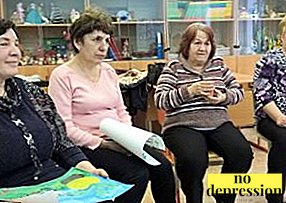There are various methods of developing attention, from the simplest to the most complex.
This mental process is important at any agesince childhood I have to offer my child various exercises.
Attentional exercises are also useful for older people in order to preserve intellectual abilities as long as possible.
What is attentiveness and what is it for a person?

Mindfulness in psychology - selective focus on a particular object or action.
It is a concentration that allows fixing the smallest details, changes in the external world, occurring around the processes.
Mindfulness allows you to see several objects at the same time and react to what is happening in a timely manner. In some cases, fractions of a second are crucial.For example, when driving a car.
An inattentive person is often mistaken. He may have problems remembering names, people, read text, with the correct account.
Inattention is especially dangerous. when performing responsible activities.
A child whose attention concentration is reduced has problems with learning and memorizing material.
Development
It’s hard for kids to do one thing hard to concentratetherefore, the task of parents and educators is to develop attentiveness.
The formation of voluntary attention in preschool children begins at about 4-5 years, although involuntary also plays a great role in mental development.

For the development of attention requires regular exercise, but they must pass on the basis of games.
That is, the child should be interested to start.
The development of attention goes through several stages:
- from 0 to 1 year. Distracted attention. The child cannot concentrate yet; he is distracted by noise or a toy;
- from year to two. Fixed type A child does something and is difficult to distract;
- two or three years. The child may be distracted if he is approached, and then return to his lesson;
- three to four years. The ability to switch from one process to another appears. This type of attention can be called a two-channel short;
- from 5-6 years old There is a two-channel prevailing attention, when the child is able to do two things at the same time, switch between them.
It is believed that attention should be developed from about this age.
Can you learn to be more attentive?

How to learn to focus attention?
In young agewhen mental processes are forming, it is easier to develop attention and imagination.
The older the person, the harderHowever, this does not mean that development is impossible. The use of special exercises, the desire to focus purposefully allows you to increase the level of attentiveness.
To learn to be more attentive, willpower is useful, since the process is associated with perseverance. If you are often distracted, then degree of concentration decreases.
It is more difficult for hyperactive people to concentrate on the subject or action, they need some effort.
If the ability to concentrate is reduced due to certain diseases or changes in the brain, then the help of a specialist is required and, possibly, the use of specific medications prescribed by the doctor.
It is also useful to pay attention to proper nutrition: the use of proteins, carbohydrates, vitamins.
Fatigue leads to a decrease in attention and memory, so proper rest and sleep is important. More often walk in the fresh air, exercise.
Methods and techniques

There are several techniques that will help train attention at preschool and school age:
- Keeping interest. The child should engage in activities with pleasure.
- Take into account age and in accordance with this, choose the duration of the lesson. For example, a 20-minute exercise is enough for a four-year-old baby, with two-year-old children doing no more than 10 minutes. Classes for schoolchildren are longer, but they are also performed taking into account a break for rest and a change of activity.
- Use for classes favorite characters baby and toys that he likes.
- Show an example. Explain that to be more attentive, the result of the activity is much better.
- Learn the alphabet and reading. Reading increases the ability to concentrate, but it is important that the child does not overwork. It is impossible to force to read, it is necessary to develop an interest in the process.
In addition to intellectual activities, attention should be paid to physical development.
Look how well does the baby breathe, deep breathing - enough oxygen should be supplied to the brain. Useful exercises with ballooning, walking in the open air, playing with soap bubbles.
Among the ways of developing attention are various targeted exercises, games, trainings.
Training and concentration practice

For training attention use exercises.
Counted age, features of the nervous system, accompanying illnesses. In some cases, you may need to consult a doctor.
If a child has hyperactivity, attention training is especially relevant. Children need develop perseverance. At the same time, intellectual exercises necessarily alternate with physical activity - the child must get rid of excess energy.
With babies and very mobile children do no more than 5-10 minutes, then take a break.
How to train mindfulness child? Exercises for children:
- Looking at pictures. The child is invited to name what is shown in the figure. In this case, it is necessary that the kid noticed various details - colors, location, elements of which the drawing consists.
- Game "What is missing". Before the child put a few items. Then they clean one and offer the baby to name what is missing.
It is necessary to begin with three simple objects whose names are familiar to the child.
- Game "Mirror". Let the child repeat the simple movements behind the adults: raise, lower the hand, clap, depict various emotions.
- "Find differences". Before the child put two drawings and offer to find how they differ.
- "Add numbers in the correct order". Suitable for children who are already a little familiar with the bill.
- "Find a pair." For each item is invited to find suitable or similar: two squares, a cup and a spoon.
- Adding puzzles. The smaller the child, the fewer elements used. The puzzle must be recognizable.
As an option - to use the cubes that make up the image.
- Game "finish". Not finished drawings are offered. The child must understand what details should be drawn.
- On the street, pay attention to what is happening around the child., count cars of the same color, notice the movement of clouds, the switching of a traffic light, what color foliage, how many people have passed by, what changes in natural phenomena occur.
- The game "True-false". The facilitator names the object and the action or property, and the child must say if this is correct. For example: a car flies, a cow barks.
- A word game. It is necessary to name words in which there is no definite letter. Another option is words containing a specific letter. For older children - a game with syllables.
- Making words from the proposed letters or other words.


How to become attentive? Development of attention for adults:
- To be in a state of "awareness." It is useful to perform on the street or in any other unfamiliar place. Look around: what items you see, how many of them, are there similar, how many cars have passed by.
If you take the same route every day, notice what changes, if the same people do not meet.
- Concentrate on what's going on around.
- Notice new properties of things. Before you is a cup: look at what color it is, if it is chipped, what bend of the handle, how quickly the tea cools down.
- Focus on the process while reading. - turn off extraneous thoughts, do not be distracted by noises, music, conversations, try to understand what is written as deeply as possible. Forget about reading "diagonally", read the paragraphs to the end, not limited to headings and individual sentences.
- Listening to music, pay attention to the words, try to grasp the meaning of the song.
- Exercise "Line". A line is drawn with a pencil on a white sheet of paper. Try to concentrate only on her, turning off all thoughts. Once distracted, leads the line up. Then straight again. So you will see how many times concentration has disappeared.
- Concentration on second hand.
- Exercise "Point". On the white sheet, draw a black dot. Hang a sheet in front of you. Relax, focus exclusively on the point. As soon as extra thoughts appear, stop, discard them.
- Candle concentration. It is more convenient to carry out in a dark or dim room. Remove distractions, light a candle and look at its flame. Pay attention to its movement, color, changes in size.
There should be no extraneous thoughts - only a complete concentration on the process.
- On the street, look at the numbers of cars, count how many cars of a certain color drove by. Remember, if you meet similar machines.
- Pay attention to people in transport - facial expressions, clothing. Notice the smallest details, imagine who they could work with, what they think, their marital status and well-being.
- Remember the names people you meet.
- Meditation. Allows you to focus on internal sensations, learns to turn off thoughts, not to respond to external noises. Meditate with or without music.
Arrange the space so that nothing distracts: unplug the phone, the doorbell, the TV.
- Hands exercise. Sit in a comfortable position, relax. Extend your right hand forward. Focus on her. Look at each finger carefully, study them. After five minutes, repeat the same with your left hand.
- Sense of smell. Walking along the street, try to feel the different smells - appreciate them, imagine the objects that emit these flavors.
- Concentration on the body. Focus on the processes occurring in the body. Feel the heartbeat, the game of muscles, the process of breathing.


Attention training - process is ongoing. Periodically, exercises should be performed to maintain and develop the ability to concentrate.
Development of attention:



